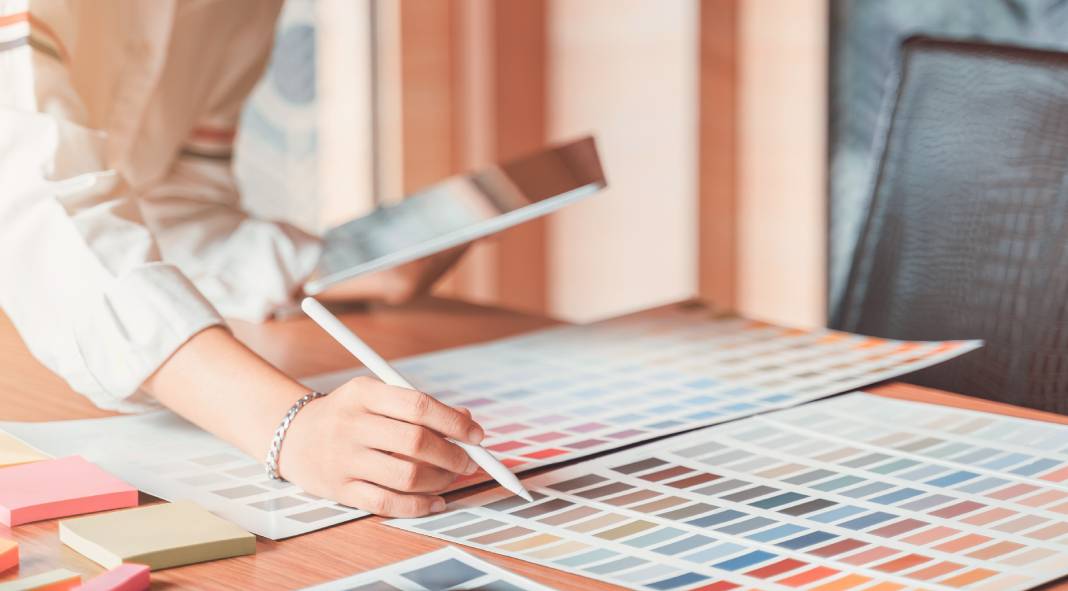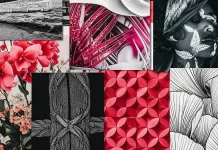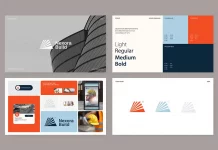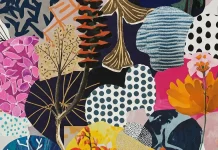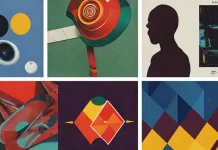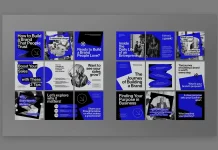In graphic design, mastering color harmony is an essential skill that can make or break your visual creations. Whether you’re a seasoned designer or just starting out, understanding the principles of color theory and applying them effectively can greatly enhance the impact of your work. In this comprehensive guide, we delve into the captivating realm of color harmony, sharing insights and tips to help you create visually stunning designs that resonate with your audience.
Color harmony is more than just choosing colors that look good together. It’s about creating a balanced and cohesive visual experience that evokes emotions, communicates messages, and establishes brand identity. From the psychology of color to the practical techniques for achieving harmony, we’ve got you covered.
The Psychology Behind Colors: Before diving into the nitty-gritty, it’s important to understand the psychological impact of different colors. Red for passion, blue for calmness, yellow for energy – each color elicits a distinct emotional response. We explore the psychology of colors and how to strategically leverage them to convey specific feelings and associations in your designs.
Colors hold a profound psychological influence over human emotions, perceptions, and behaviors, making them a cornerstone of effective graphic design. Each hue carries inherent associations and triggers specific emotional responses. Warm colors like red and orange evoke feelings of passion, energy, and urgency, making them ideal for grabbing attention and conveying excitement. On the other hand, cool tones like blue and green inspire tranquility, calmness, and reliability, often used in contexts that require a sense of trust and professionalism. Yellow radiates positivity, optimism, and warmth, making it suitable for designs aimed at uplifting spirits. Furthermore, culturally and contextually, colors can carry unique meanings, adding an extra layer of depth to their psychological impact. By harnessing the psychology behind colors, graphic designers can strategically align visual elements with the intended message, connecting with audiences on a visceral level and forging a lasting impression that transcends mere aesthetics.
Color Theory Fundamentals: Delving into the foundations of color theory, we break down concepts like the color wheel, complementary and analogous colors, and warm vs. cool hues. By grasping these basics, you’ll have a solid foundation for creating harmonious color schemes that captivate your audience’s attention.
Color theory serves as the essential compass guiding graphic designers in their quest to create harmonious and visually captivating compositions. At its core lies the color wheel, a visual representation of the relationships between primary, secondary, and tertiary colors. Complementary colors, positioned opposite each other on the wheel, offer a dynamic contrast that can command attention when used judiciously. Analogous colors, situated next to each other, provide a more subdued yet harmonious palette for a balanced and soothing effect. The interplay between warm and cool colors generates contrast and depth, enabling designers to create visual hierarchy and direct the viewer’s gaze. Tapping into color temperature and intensity empowers designers to evoke specific emotions or moods – warm tones elicit passion, while cool tones evoke calmness. Understanding these fundamental concepts empowers graphic designers to make deliberate choices, resulting in compositions that resonate with viewers through a masterful interplay of colors.
Creating Harmonious Color Schemes: Discover practical techniques for crafting color palettes that harmonize effortlessly. From monochromatic and analogous schemes to complementary and split-complementary arrangements, we explore the various ways to combine colors to achieve balance and visual appeal. Learn how to avoid overwhelming your designs and instead create eye-catching yet harmonious compositions.
As a graphic designer, mastering the art of harmonious color schemes is a cornerstone of crafting compelling visuals. Diverse techniques come into play, each contributing to balance and visual allure. Monochromatic schemes, built around a single hue in varying shades, evoke elegance and simplicity, ensuring a seamless visual experience. Analogous schemes, where neighboring colors on the wheel are utilized, provide a soft transition that avoids overwhelming the viewer, making them perfect for conveying unity and serenity. For a striking contrast, complementary schemes use colors directly opposite on the wheel, creating vibrant compositions that command attention without sacrificing harmony. Delving further, split-complementary arrangements introduce a trio of colors, where one hue is paired with the adjacent colors to the complementary shade, allowing for a more nuanced balance of vibrancy and cohesiveness. By skillfully navigating these techniques, designers can harmonize color choices to create captivating yet balanced designs that resonate on multiple levels, leaving viewers engaged and inspired.
Color in Branding and Marketing: Colors play a significant role in branding and marketing strategies. We examine the stories behind some of the world’s most iconic brands and how their color choices have influenced consumer perceptions and loyalty. Whether you’re designing a logo, website, or promotional materials, understanding color’s impact on brand identity is crucial.
Color is an instrumental tool in branding and marketing, wielding the power to shape consumer perceptions and foster unwavering brand loyalty. The stories of iconic global brands illuminate the profound influence of color choices. Consider Coca-Cola’s red – a timeless hue that exudes energy and warmth, aligning perfectly with the brand’s spirited and joyful identity. Apple’s sleek and minimalist white aesthetic portrays sophistication and innovation, reinforcing the brand’s reputation for cutting-edge technology. The calming blue of Facebook resonates with trust and connectivity, positioning the platform as a reliable social network. These stories underscore how color becomes synonymous with a brand’s essence, embedding emotions and values into the minds of consumers. For designers, whether working on logos, websites, or promotional materials, comprehending color’s role in brand identity is pivotal. The right color choices evoke desired emotions, cultivate associations, and foster recognition, ultimately steering consumer choices and building enduring connections that extend beyond mere visuals.
Tools for Choosing and Combining Colors: Navigating the myriad of colors available can be overwhelming. We introduce you to a range of online tools and resources that simplify the process of choosing and combining colors. From color palette generators to digital color wheels, these tools will become your allies in achieving impeccable color harmony.
Harnessing the potential of color is greatly facilitated by a plethora of online tools and resources. These valuable aids streamline the intricate process of selecting and harmonizing colors, enabling designers to achieve flawless color harmony. Color palette generators serve as a virtual artist’s palette, offering an array of pre-selected color combinations or allowing customization based on your preferences. These generators eliminate guesswork, ensuring that the colors you choose align seamlessly. Digital color wheels, another indispensable tool, empower designers to visualize relationships between colors, facilitating the creation of analogous, complementary, or split-complementary schemes with ease. Moreover, color theory websites provide in-depth insights into the fundamentals of color harmony, enabling designers to deepen their understanding while refining their color choices. As these tools become an integral part of your design arsenal, you’ll find yourself crafting harmonious and captivating compositions with the confidence and precision that only advanced technology can offer.
Combining colors effectively entails adhering to color theory principles such as complementary, analogous, or triadic color schemes. These schemes help create harmonious and balanced compositions by leveraging relationships between colors on the color wheel.
In Adobe Photoshop, the Swatches panel allows designers to save and organize their chosen colors for easy access throughout the project. This aids in maintaining a consistent color palette across various elements of the design.
The Gradient tool in Photoshop empowers designers to blend colors seamlessly, producing gradients that can be linear, radial, or even custom-designed. Gradients add depth and dimension to designs, enhancing visual appeal.
Case Studies and Real-World Examples: What better way to grasp the power of color harmony than through real-world examples? We showcase a series of case studies from diverse industries, dissecting their color choices and explaining how they contribute to the overall message and design aesthetics.
Let’s delve into captivating case studies that illuminate how this intricate interplay of hues influences design across varied industries. In the realm of technology, the sleek blues and whites of IBM’s branding exude trustworthiness and innovation, aligning seamlessly with their cutting-edge solutions. Transitioning to the food and beverage sector, Starbucks’ earthy greens evoke a sense of natural freshness and relaxation, embodying their commitment to quality and sustainability. The world of fashion finds Chanel utilizing a timeless black-and-white palette, epitomizing elegance, and timelessness in every detail. The healthcare industry capitalizes on soft and calming blues, with companies like Pfizer resonating a sense of reliability and well-being. These case studies exemplify how color choices aren’t arbitrary, but strategic decisions deeply ingrained in a brand’s identity and message. Through each example, it becomes evident that color harmony serves as a silent yet powerful communicator, fostering connections between brands and consumers by tapping into emotional responses and reinforcing overarching themes. The art of color harmony is indeed a universal language, seamlessly weaving its threads through the diverse tapestry of design across industries.
The Future of Color in Design: As design trends evolve, so do color preferences and applications. We take a peek into the emerging color trends and innovative uses of color in the ever-evolving landscape of graphic design.
As the landscape of graphic design continues to evolve, the realm of color remains at the forefront of innovation and creativity. Stepping into the future, we are met with a dynamic canvas of emerging color trends that promise to redefine the visual narrative. The rise of technology-driven design has birthed an era of vibrant neons and digital-inspired palettes, encapsulating the spirit of the digital age. Simultaneously, there’s a growing fascination with muted and pastel tones, fostering a sense of nostalgia and calm in a fast-paced world. The exploration of gradients and duotones introduces depth and dimension, while metallic shades infuse a touch of luxury into modern aesthetics. Moreover, the interplay of unexpected color combinations is gaining momentum, challenging traditional norms and opening new doors of creativity. Beyond aesthetics, color is also being leveraged to enhance accessibility and inclusivity, ensuring that designs resonate with diverse audiences. As we venture into the future, the world of color in design beckons us to embrace these trends and innovative applications, empowering designers to craft narratives that resonate deeply with the ever-evolving sensibilities of the modern world.
Conclusion: Color harmony is an art that can elevate your graphic design projects to new heights. By understanding the psychology, theory, and practical techniques behind harmonious color combinations, you’ll be better equipped to create visuals that leave a lasting impression. Whether you’re designing for personal projects or professional clients, the principles of color harmony will remain a cornerstone of captivating design.
Unlock the magic of color harmony in your graphic design journey. Elevate your skills and captivate your audience with designs that resonate on a deeper level. Embrace the world of colors, and let your creativity shine.
Header image by kenchiro168 via Adobe Stock. Get inspired in our graphic design and branding categories. You can learn more about color harmony on Wikipedia.
Subscribe to our newsletter!

